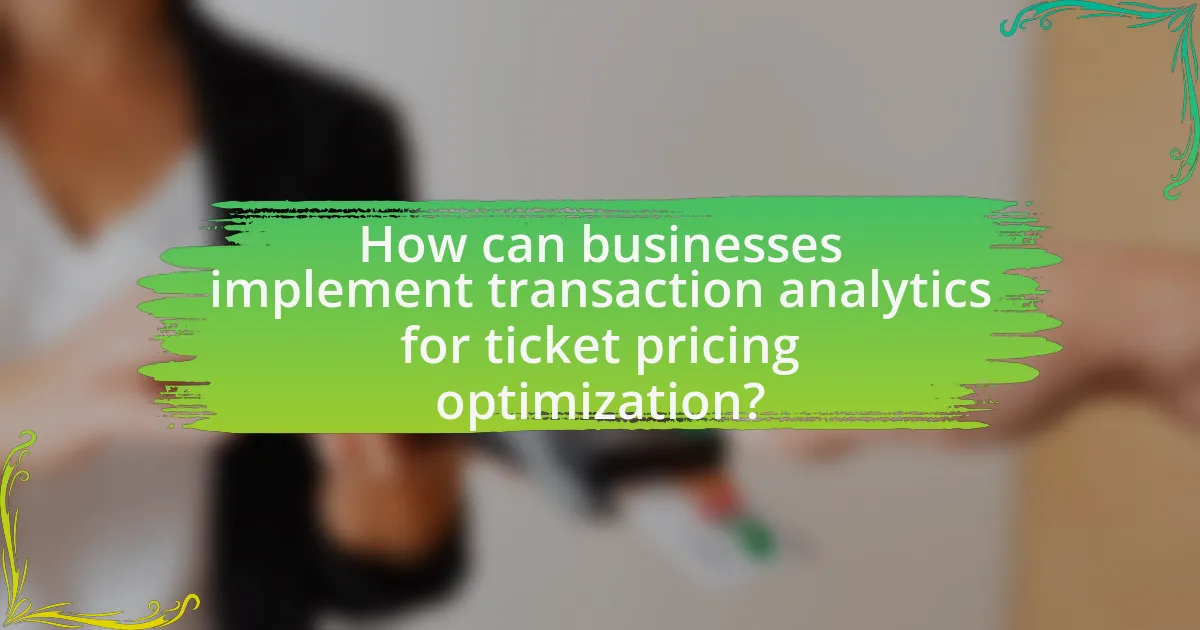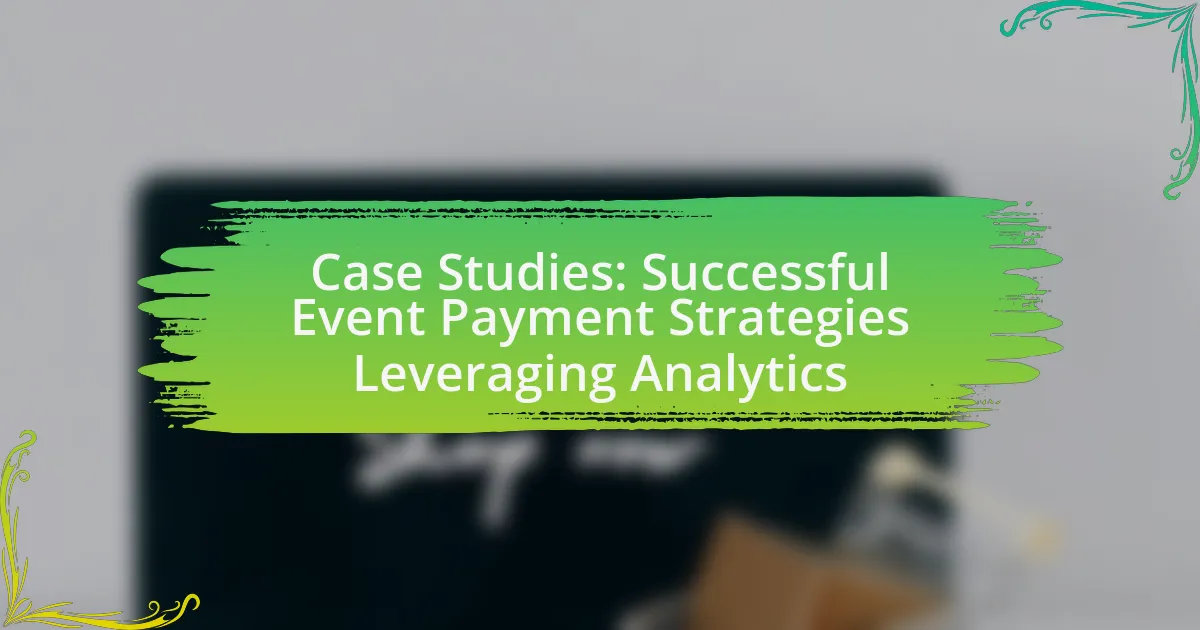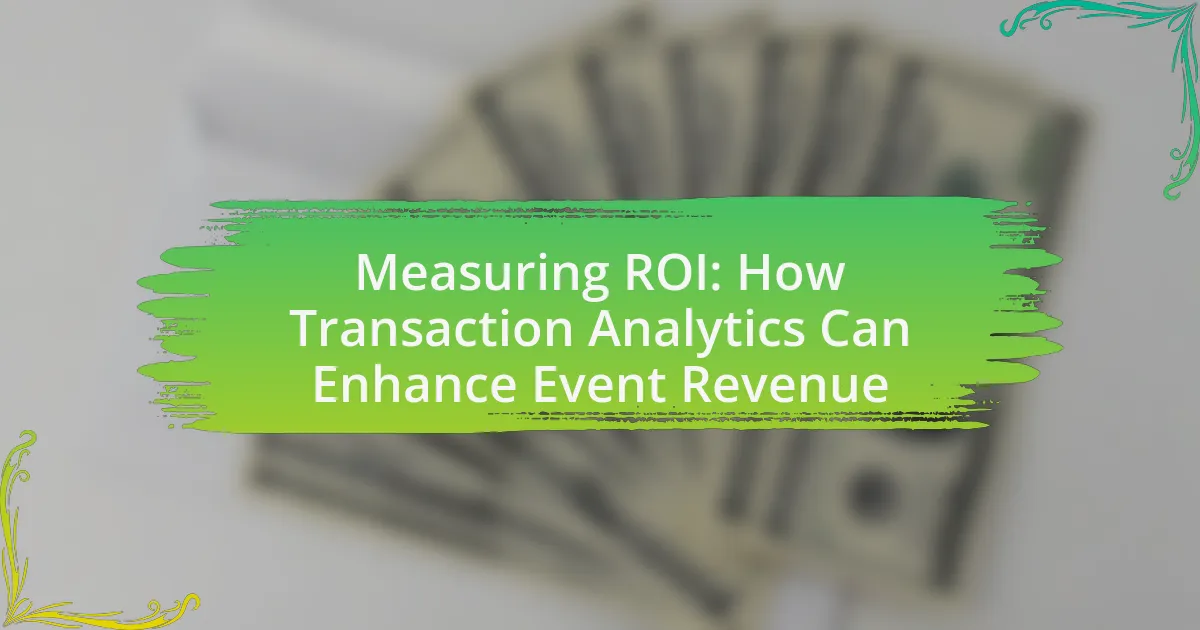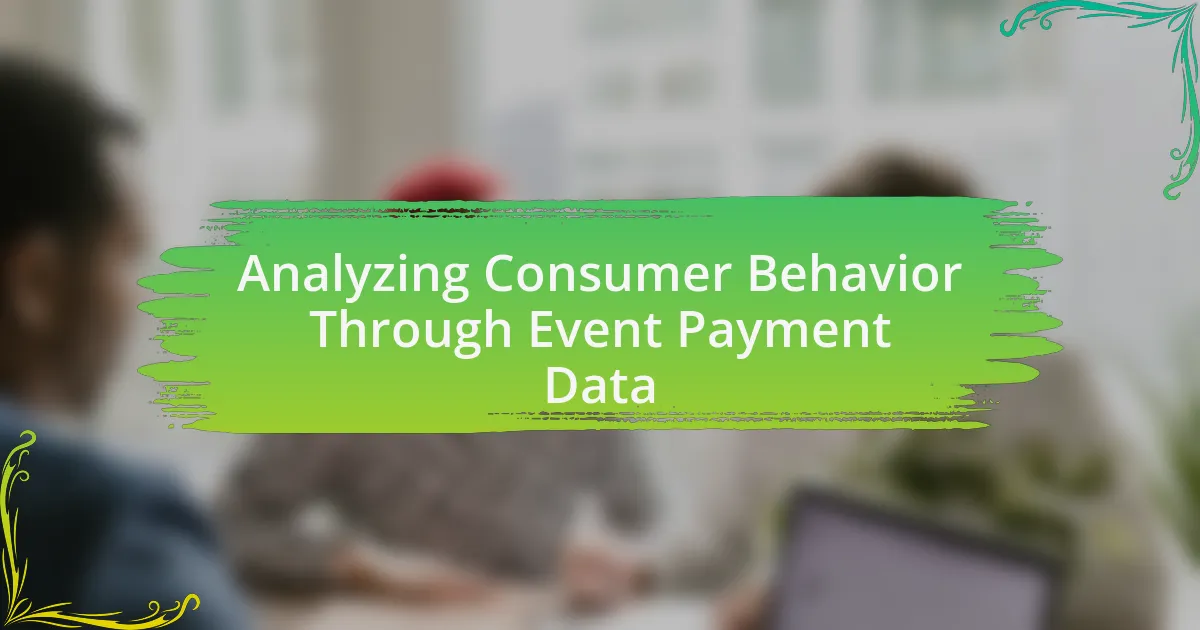Ticket Pricing Optimization Using Transaction Analytics is a data-driven approach that utilizes historical ticket sales data to develop effective pricing strategies for future sales. The article explores how transaction analytics influences pricing decisions by analyzing consumer behavior, market demand, and competitor pricing, ultimately leading to improved revenue and profitability. Key components discussed include data sources, customer behavior analysis, and the implementation of dynamic pricing strategies. Additionally, the article highlights best practices for leveraging transaction analytics, common pitfalls to avoid, and practical tips for optimizing ticket pricing to enhance customer satisfaction and loyalty.
What is Ticket Pricing Optimization Using Transaction Analytics?

Ticket Pricing Optimization Using Transaction Analytics is the process of utilizing data derived from past ticket sales to determine the most effective pricing strategies for future sales. This approach leverages transaction data, such as purchase patterns, customer demographics, and market demand, to identify optimal price points that maximize revenue and sales volume. For instance, airlines and event organizers often analyze historical sales data to adjust prices dynamically based on factors like seasonality and competitor pricing, leading to improved financial outcomes.
How does transaction analytics influence ticket pricing strategies?
Transaction analytics significantly influences ticket pricing strategies by providing data-driven insights into consumer behavior and market demand. By analyzing past transaction data, organizations can identify trends such as peak purchasing times, customer preferences, and price sensitivity. For instance, a study by the Harvard Business Review found that companies using transaction analytics improved their pricing accuracy by up to 20%, leading to increased revenue. This data allows businesses to implement dynamic pricing models, adjusting ticket prices in real-time based on demand fluctuations, competitor pricing, and inventory levels. Consequently, transaction analytics enables more strategic pricing decisions that align with market conditions and consumer willingness to pay.
What data sources are utilized in transaction analytics for ticket pricing?
Transaction analytics for ticket pricing utilizes various data sources, including historical sales data, customer demographics, competitor pricing, and market demand indicators. Historical sales data provides insights into past pricing trends and customer purchasing behavior, while customer demographics help in understanding target audiences and their price sensitivity. Competitor pricing data allows for benchmarking against similar offerings, and market demand indicators, such as event popularity and seasonality, inform pricing strategies to maximize revenue. These data sources collectively enable more informed decision-making in setting optimal ticket prices.
How is transaction data analyzed to inform pricing decisions?
Transaction data is analyzed to inform pricing decisions by examining patterns in customer purchases, demand fluctuations, and competitor pricing. This analysis involves collecting data on sales volume, customer demographics, and purchase timing, which helps identify trends and preferences. For instance, historical sales data can reveal peak purchasing times, allowing businesses to adjust prices dynamically to maximize revenue. Additionally, comparing transaction data with competitor pricing enables companies to position their prices strategically within the market. This data-driven approach leads to more informed pricing strategies that align with consumer behavior and market conditions.
Why is optimizing ticket pricing important for businesses?
Optimizing ticket pricing is crucial for businesses because it directly impacts revenue and profitability. Effective pricing strategies enable businesses to maximize sales by aligning prices with consumer demand and willingness to pay. For instance, research indicates that dynamic pricing can increase revenue by up to 25% in industries such as airlines and entertainment. By analyzing transaction data, businesses can identify pricing trends and customer behavior, allowing for adjustments that enhance competitiveness and market share.
What impact does ticket pricing have on revenue and profitability?
Ticket pricing significantly impacts revenue and profitability by directly influencing sales volume and consumer demand. Higher ticket prices can lead to increased revenue per sale, but may also reduce the total number of tickets sold, potentially lowering overall revenue. Conversely, lower ticket prices can boost sales volume, enhancing total revenue, but may decrease profit margins if the price does not cover costs. For instance, a study by the National Bureau of Economic Research found that a 10% increase in ticket prices can lead to a 5% decrease in attendance, illustrating the delicate balance between pricing and demand. Therefore, effective ticket pricing strategies must consider both revenue generation and profitability to optimize financial outcomes.
How does effective pricing enhance customer satisfaction and loyalty?
Effective pricing enhances customer satisfaction and loyalty by aligning perceived value with actual cost, leading to a positive customer experience. When customers feel they are receiving fair value for their money, they are more likely to return and recommend the service to others. Research indicates that 70% of consumers are willing to pay more for a better customer experience, which underscores the importance of pricing strategies that reflect customer expectations and market conditions. Additionally, effective pricing can create a sense of trust and transparency, further solidifying customer loyalty.
What are the key components of transaction analytics in ticket pricing?

The key components of transaction analytics in ticket pricing include data collection, pricing strategy analysis, customer behavior insights, and performance metrics evaluation. Data collection involves gathering information on ticket sales, customer demographics, and market trends, which provides a comprehensive view of the ticketing landscape. Pricing strategy analysis examines how different pricing models, such as dynamic pricing or tiered pricing, impact sales and revenue. Customer behavior insights focus on understanding purchasing patterns and preferences, enabling more targeted marketing efforts. Finally, performance metrics evaluation assesses the effectiveness of pricing strategies through key performance indicators like revenue per ticket and sales volume, ensuring that pricing decisions are data-driven and aligned with market demand.
How do historical sales data contribute to pricing optimization?
Historical sales data significantly contribute to pricing optimization by providing insights into customer purchasing behavior and market demand trends. Analyzing past sales patterns allows businesses to identify peak sales periods, customer price sensitivity, and the effectiveness of previous pricing strategies. For instance, a study by McKinsey & Company found that companies leveraging historical sales data for pricing decisions can increase their revenue by 2-7%. This data-driven approach enables organizations to set competitive prices that maximize profit while aligning with consumer expectations and market conditions.
What patterns can be identified from historical sales data?
Patterns identified from historical sales data include seasonal trends, customer purchasing behavior, and price sensitivity. Seasonal trends often show fluctuations in sales volume during specific times of the year, such as increased ticket sales during holidays or major events. Customer purchasing behavior can reveal preferences for certain types of tickets or times of purchase, indicating peak buying periods. Price sensitivity analysis demonstrates how changes in ticket prices affect sales volume, allowing for strategic pricing adjustments. For instance, data may show that a 10% price reduction leads to a 15% increase in sales, highlighting the importance of pricing strategies in maximizing revenue.
How can seasonality and trends affect ticket pricing strategies?
Seasonality and trends significantly influence ticket pricing strategies by dictating demand fluctuations throughout the year. For instance, during peak seasons, such as holidays or major events, ticket prices typically increase due to higher demand, while off-peak seasons may see reduced prices to stimulate sales. Historical data shows that airlines often raise prices by 20-30% during summer vacations and holidays, reflecting increased consumer willingness to pay during these times. Additionally, trends such as economic conditions or consumer preferences can lead to adjustments in pricing strategies; for example, a rise in disposable income may encourage higher ticket prices. Thus, understanding seasonality and trends allows businesses to optimize pricing dynamically, maximizing revenue while remaining competitive.
What role does customer behavior analysis play in ticket pricing?
Customer behavior analysis plays a crucial role in ticket pricing by enabling companies to understand demand patterns and price sensitivity among different customer segments. This analysis allows businesses to tailor their pricing strategies based on historical purchasing data, preferences, and trends, leading to optimized revenue. For instance, airlines and event organizers often utilize dynamic pricing models that adjust ticket prices in real-time based on customer behavior indicators such as search frequency, booking time, and competitor pricing. Research indicates that companies employing customer behavior analysis can increase their revenue by up to 20% by effectively aligning prices with consumer willingness to pay.
How can customer segmentation improve pricing strategies?
Customer segmentation can significantly enhance pricing strategies by allowing businesses to tailor their pricing models to specific groups based on their purchasing behavior and willingness to pay. By analyzing transaction data, companies can identify distinct customer segments, such as price-sensitive consumers or premium buyers, and adjust prices accordingly to maximize revenue. For instance, a study by McKinsey & Company found that companies employing customer segmentation in their pricing strategies can achieve revenue increases of 5% to 15%. This targeted approach ensures that businesses capture more value from each segment, leading to improved overall profitability.
What insights can be gained from analyzing purchasing patterns?
Analyzing purchasing patterns provides insights into consumer behavior, preferences, and trends. These insights can help businesses identify peak purchasing times, popular products, and customer demographics. For instance, a study by McKinsey & Company found that understanding purchasing patterns can lead to a 10-20% increase in sales by optimizing inventory and marketing strategies based on consumer demand. Additionally, analyzing these patterns allows companies to tailor pricing strategies, enhancing revenue management by adjusting prices according to demand fluctuations and customer segments.
How can businesses implement transaction analytics for ticket pricing optimization?

Businesses can implement transaction analytics for ticket pricing optimization by analyzing historical sales data to identify patterns in customer behavior and demand fluctuations. By utilizing advanced analytics tools, companies can segment their customer base, assess price elasticity, and forecast future sales trends based on various factors such as seasonality and event popularity. For instance, a study by McKinsey & Company found that organizations using data-driven pricing strategies can increase revenue by 2-7%. This evidence supports the effectiveness of transaction analytics in making informed pricing decisions that align with market demand.
What tools and technologies are available for transaction analytics?
Tools and technologies available for transaction analytics include data visualization software, machine learning algorithms, and database management systems. Data visualization tools like Tableau and Power BI enable users to create interactive dashboards that display transaction data effectively. Machine learning algorithms, such as regression analysis and clustering techniques, help identify patterns and trends in transaction data, facilitating better decision-making. Database management systems like SQL and NoSQL databases store and manage large volumes of transaction data, ensuring efficient retrieval and analysis. These tools collectively enhance the ability to analyze transaction data, leading to optimized ticket pricing strategies.
How do data visualization tools enhance understanding of pricing data?
Data visualization tools enhance understanding of pricing data by transforming complex datasets into visual formats that are easier to interpret. These tools allow users to identify trends, patterns, and anomalies in pricing data quickly, facilitating informed decision-making. For instance, a study by the Journal of Business Research found that visual representations of data can improve comprehension by up to 80% compared to traditional data tables. This increased clarity helps stakeholders grasp pricing dynamics, optimize strategies, and respond effectively to market changes.
What software solutions are best suited for ticket pricing analytics?
The best software solutions for ticket pricing analytics include FareHarbor, Eventbrite, and PriceLabs. FareHarbor offers dynamic pricing tools that allow businesses to adjust ticket prices based on demand and market trends. Eventbrite provides comprehensive analytics features that help event organizers understand ticket sales patterns and optimize pricing strategies. PriceLabs specializes in revenue management and dynamic pricing, utilizing historical data and market insights to recommend optimal ticket prices. These solutions are validated by their widespread use in the industry, demonstrating effectiveness in enhancing revenue through data-driven pricing strategies.
What best practices should businesses follow when optimizing ticket pricing?
Businesses should implement dynamic pricing strategies when optimizing ticket pricing. Dynamic pricing allows businesses to adjust ticket prices in real-time based on demand, competition, and customer behavior. For instance, research by the Harvard Business Review indicates that airlines and hotels have successfully used dynamic pricing to maximize revenue, with some companies reporting revenue increases of up to 30% by adjusting prices based on real-time data. Additionally, businesses should analyze historical sales data to identify trends and peak purchasing times, enabling them to set prices that reflect customer willingness to pay. This data-driven approach ensures that pricing strategies are aligned with market conditions and consumer preferences, ultimately leading to improved sales and customer satisfaction.
How can continuous monitoring and adjustment improve pricing strategies?
Continuous monitoring and adjustment enhance pricing strategies by enabling businesses to respond dynamically to market changes and consumer behavior. This approach allows companies to analyze real-time data, such as sales trends and competitor pricing, facilitating timely price modifications that align with demand fluctuations. For instance, a study by McKinsey & Company found that companies employing dynamic pricing strategies can increase revenue by 2-5% through optimized pricing adjustments based on continuous market analysis. By leveraging transaction analytics, organizations can identify patterns and insights that inform pricing decisions, ensuring they remain competitive and maximize profitability.
What common pitfalls should be avoided in ticket pricing optimization?
Common pitfalls to avoid in ticket pricing optimization include neglecting data analysis, failing to segment customers, and not considering market dynamics. Neglecting data analysis can lead to uninformed pricing decisions, as historical sales data and customer behavior insights are crucial for setting optimal prices. Failing to segment customers results in a one-size-fits-all pricing strategy, which may alienate potential buyers who are willing to pay different amounts based on their willingness to pay and preferences. Not considering market dynamics, such as competitor pricing and external economic factors, can result in prices that are either too high or too low, ultimately affecting sales and revenue. These pitfalls can significantly hinder the effectiveness of pricing strategies and lead to lost revenue opportunities.
What are practical tips for leveraging transaction analytics in ticket pricing?
To leverage transaction analytics in ticket pricing effectively, organizations should focus on analyzing historical sales data to identify pricing trends and customer behavior patterns. This analysis allows for dynamic pricing strategies that adjust ticket prices based on demand fluctuations, time to event, and customer segments. For instance, using data from previous events, organizations can determine optimal price points that maximize revenue while minimizing unsold inventory. Additionally, integrating real-time analytics can help in monitoring competitor pricing and market conditions, enabling timely adjustments. Research indicates that companies employing data-driven pricing strategies can increase revenue by up to 25%, demonstrating the effectiveness of transaction analytics in optimizing ticket pricing.






